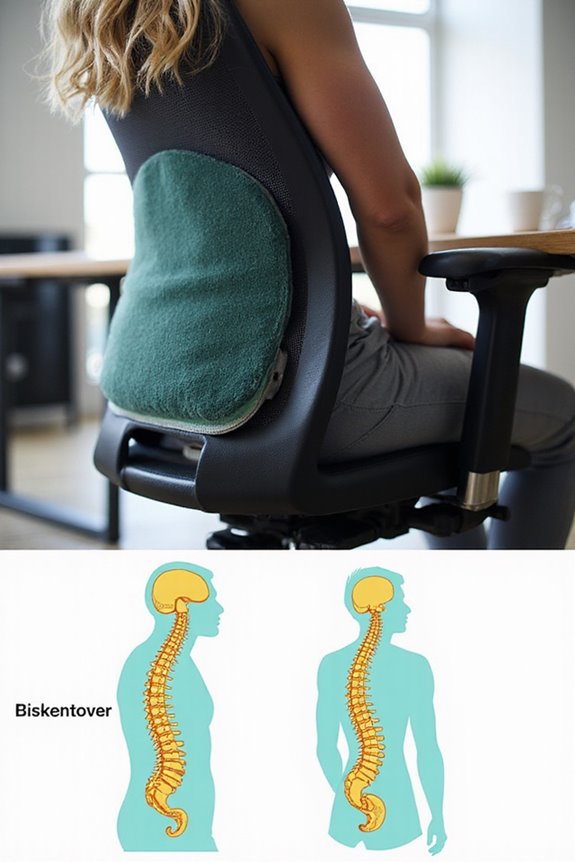A lumbar support cushion functions by filling the gap between the lower back and the chair back, maintaining the natural lumbar curve. This support alleviates pressure, distributes body weight evenly, and prevents unnatural bending. Utilizing high-density foam, it adapts to individual spinal shapes, enhancing comfort and alignment during prolonged sitting. Research indicates that consistent use can reduce low back pain and improve mobility. Further insights reveal various types and ergonomic impacts on spinal health.
Key Takeaways
- Lumbar support cushions fill the gap between the lower back and chair, maintaining the natural inward curve of the spine.
- They distribute body weight evenly across the lower back, reducing pressure and enhancing comfort during prolonged sitting.
- The high-density foam molds to the shape of the back, providing personalized support and promoting long-term comfort.
- Adjustable features allow users to align the cushion with their individual lumbar curves for optimal support.
- By maintaining lumbar lordosis, these cushions help reduce strain, muscle fatigue, and improve blood circulation in the lower back.
Understanding Lumbar Support Cushions
Lumbar support cushions are essential tools for promoting spinal health and enhancing comfort during prolonged sitting. Made primarily from foam materials, these cushions are designed to adapt to the natural curvature of the lumbar spine, ensuring personalized support.
Cushion Materials:
- Memory foam is commonly used, as it evenly distributes pressure and molds to body shapes.
- Some designs feature an aperture to support the posterior pelvic area.
User Demographics:
- Ideal for office workers, individuals working from home, and travelers.
- Beneficial for people of shorter stature, addressing gaps between lumbar support and non-ergonomic chairs.
These ergonomic accessories can transform standard seating into supportive environments, catering to a diverse range of users seeking improved spinal alignment and comfort.
Mechanism of Support
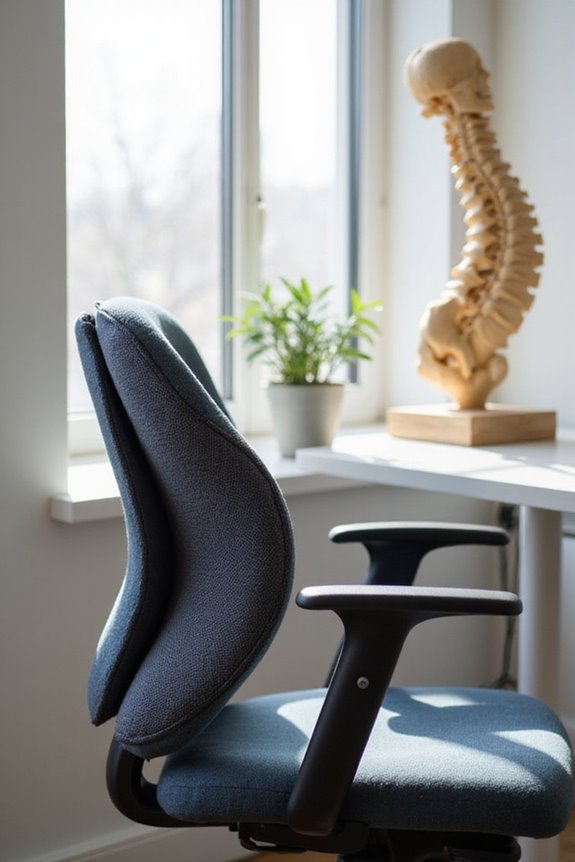
The mechanism of support provided by lumbar support cushions is critical for enhancing comfort and promoting proper spinal alignment. These cushions fill the gap between the lumbar region and chair back, maintaining the natural inward curve of the lower spine, known as lordosis, thereby preventing slouching.
- Pressure Mapping: The cushions utilize gentle pressure mapping to evenly distribute body weight across the lower back, reducing stress on specific vertebrae.
- Side Stabilization: They offer lateral support, preventing unnatural side bending or twisting.
Adjustable features allow for ideal alignment with individual lumbar curves, while high-density foam molds to the back’s shape. This combination promotes long-term comfort and minimizes strain during prolonged sitting, reinforcing proper posture throughout the day.
Scientific and Medical Benefits
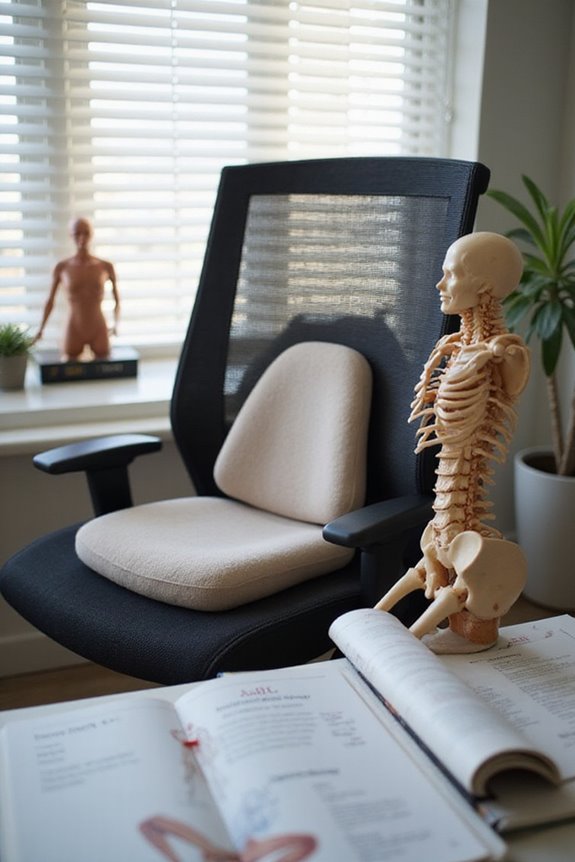
Research highlights numerous scientific and medical benefits associated with the use of lumbar support cushions, particularly in mitigating low back pain and enhancing overall spinal health.
Pain Management and Mobility Improvement
- Lumbar support cushions considerably reduce low back pain intensity and chronic inflammation.
- Studies indicate improved lumbar range of motion, facilitating better mobility.
- Integration with other interventions enhances pain relief and movement more effectively than therapy or medication alone.
Spinal Alignment and Muscle Relaxation
- These cushions maintain natural lumbar lordosis, reducing strain and muscle fatigue.
- Enhanced blood circulation in the lower back promotes tissue regeneration and decreases inflammation.
- Prolonged use prevents slouched posture, subsequently protecting against neck and shoulder pain.
Types of Lumbar Support
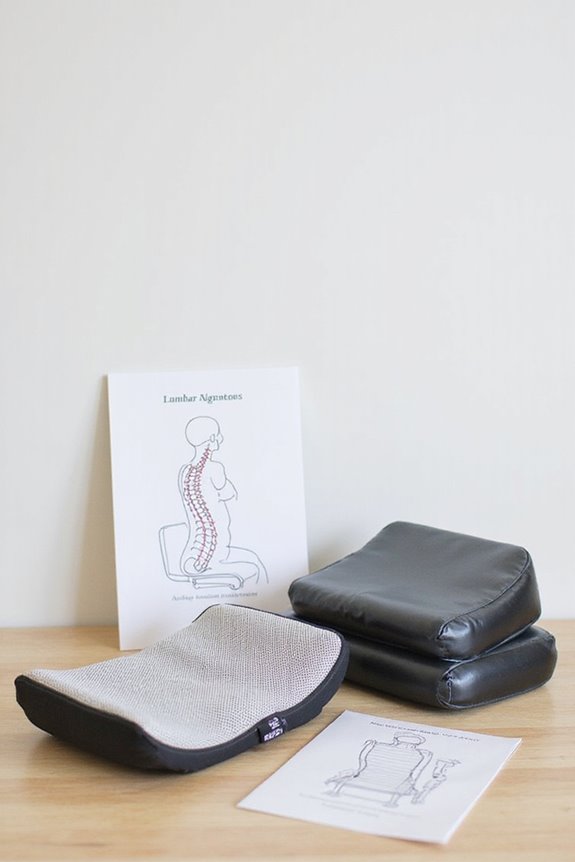
Various types of lumbar support cushions cater to specific needs and preferences, ensuring that users can find suitable options for their unique situations.
Fixed Supports
These are integrated into chair backs, providing consistent support without adjustment.
Adjustable Supports
These feature mechanisms allowing users to modify height or firmness based on comfort.
External Cushions
Separate pads or pillows that can be added to existing chairs for additional support.
Dynamic Supports
These adjust automatically with body movement, ensuring continuous support.
Contour Cushions
Designed to follow the natural curvature of the spine, providing an ergonomic fit.
Material Variations
Options include memory foam, gel-filled, and latex foam, each offering distinct advantages in support and comfort.
Ergonomic Impact
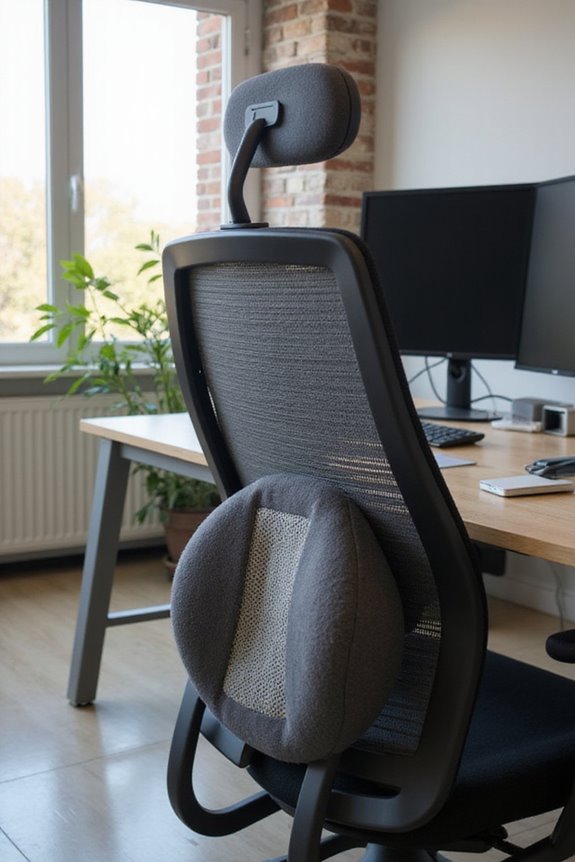
Ergonomic impact is a critical aspect of lumbar support cushion functionality, as these devices play an essential role in maintaining spinal health.
- Posture Awareness: Lumbar support cushions promote awareness of posture, encouraging users to maintain proper alignment of the pelvis, lumbar spine, and thoracic spine. Enhanced awareness contributes to healthier seating habits.
- Comfort Enhancement: These cushions distribute weight evenly, reducing lower back pain and muscle fatigue. Research indicates significant improvements in comfort and pain relief during prolonged sitting.
- Long-Term Benefits: Consistent use of lumbar cushions can retrain postural muscles, fostering better habits even when the cushion is not in use. This proactive approach helps mitigate risks associated with poor posture, contributing to overall well-being and productivity.
Practical Considerations
When selecting a lumbar support cushion, practical considerations are paramount to assure peak performance and user satisfaction.
Cushion Design and Fit
- Choose cushions with high-density memory foam or gel-infused materials for peak comfort.
- Confirm adjustable straps secure the cushion to various chair types, minimizing slippage.
Usage Guidelines
- Position the cushion at the small of the back for effective lumbar support.
- Consistent use during daily activities maximizes benefits.
Maintenance
- Opt for cushions with removable covers for easy washing and hygiene.
- Regularly inspect for wear; replace if firmness diminishes.
User Feedback
- Consider feedback on firmness levels, as comfort must balance support.
- Evaluate the cushion’s portability for multi-environment use, enhancing overall practicality.
Frequently Asked Questions
How Do I Choose the Right Lumbar Support Cushion Size?
Choosing the right lumbar support cushion size involves evaluating personal body dimensions and furniture type. Opt for suitable cushion materials that enhance comfort while ensuring proper support for the lower back, fostering a sense of belonging and well-being.
Can Lumbar Support Cushions Be Used With Any Chair Type?
Lumbar support cushions can adapt to various chair types, including ergonomic chairs and standard office setups. Their versatility fosters comfort, encouraging users to create supportive environments that promote well-being and a sense of belonging in diverse spaces.
How Often Should I Replace My Lumbar Support Cushion?
Replacement frequency for lumbar support cushions largely depends on cushion durability, wear signs, and user needs. Regular evaluations, typically every 6–12 months, guarantee ideal support and comfort, fostering a sense of belonging in shared spaces.
Are There Any Specific Care Instructions for Lumbar Support Cushions?
Care instructions for lumbar support cushions resemble nurturing a cherished companion; regular cleaning tips and maintenance guidelines breathe life into comfort. By lovingly tending to their needs, users guarantee lasting support and embrace a relationship of well-being.
Can Children Use Lumbar Support Cushions Safely?
Children can safely use lumbar support cushions, enhancing child safety and comfort. These cushions provide significant benefits, alleviating lower back pressure during seated activities, promoting proper posture, and supporting healthy development while encouraging active engagement in various tasks.

